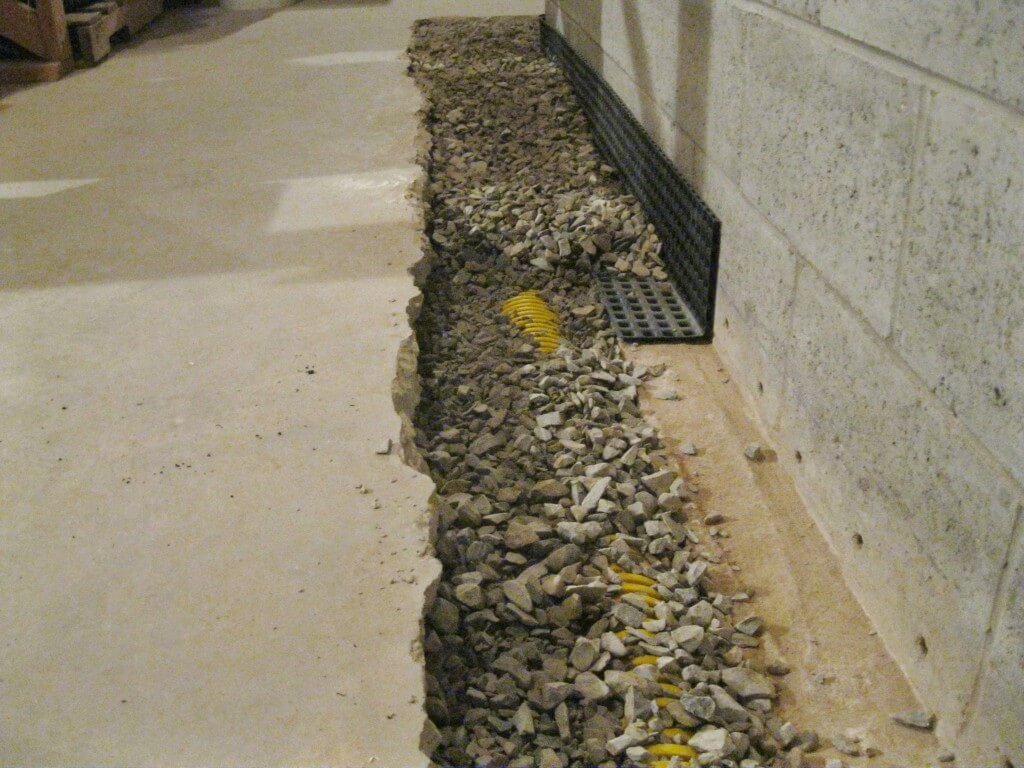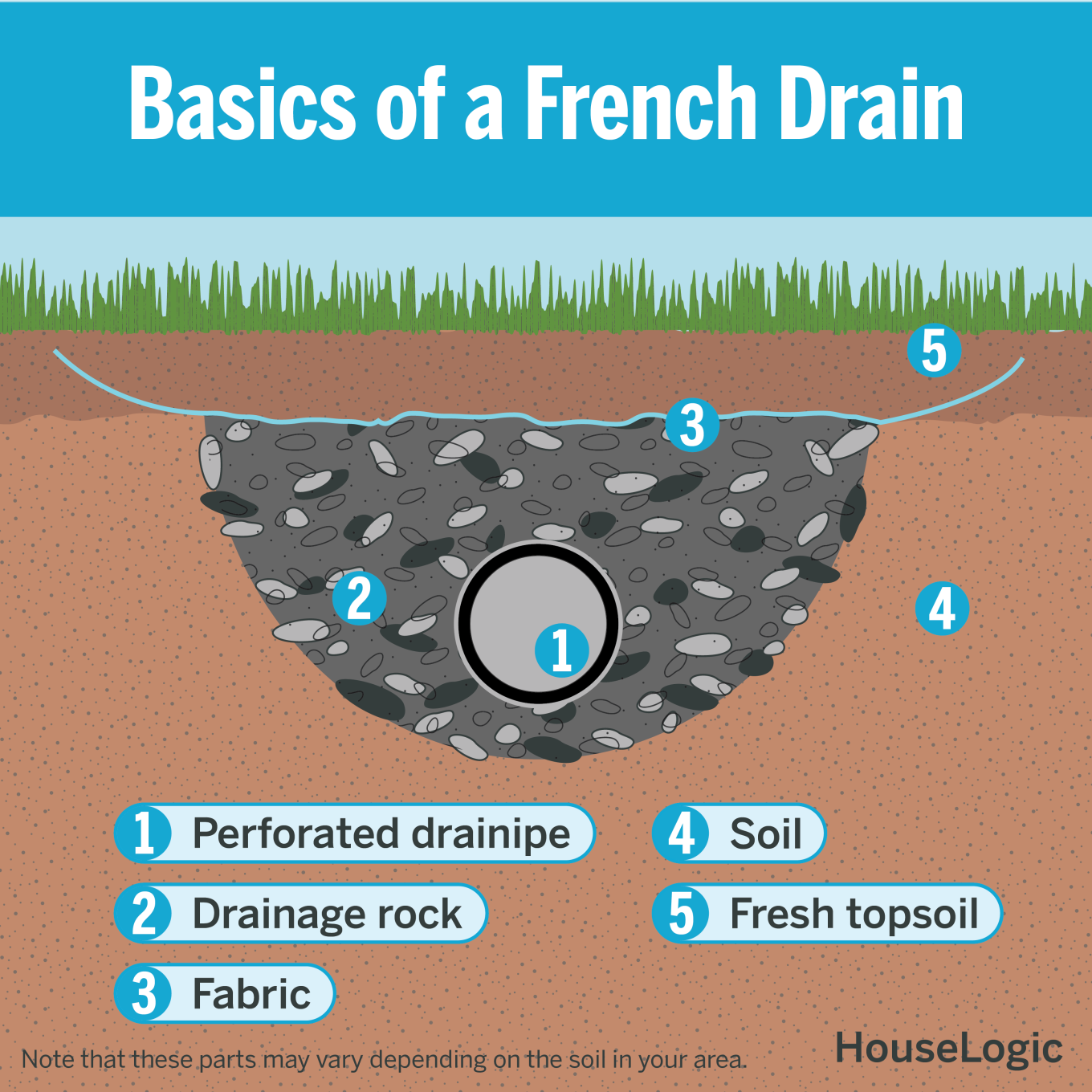Just How a French Drainpipe Can Help Prevent Water Damage in Your Cellar
A French drainpipe may be the solution you need if you're dealing with a moist basement. This system efficiently redirects water far from your foundation, assisting to avoid pricey damages. Comprehending exactly how it works and acknowledging the indications that you need one can make a considerable difference in your house's safety and convenience. Before you make a decision, it's vital to discover the benefits and setup procedure to see if it's the appropriate fit for your situation.
What Is a French Drainpipe?
A French drain is a simple yet efficient service for handling excess water around your residential property. It's designed to redirect water far from susceptible areas, like your cellar or foundation. Generally, it includes a trench full of gravel and a perforated pipeline that collects and networks water. When rainwater or groundwater accumulates, the drain successfully overviews it away, preventing possible damage.You could discover French drains pipes installed along residential or commercial property lines, driveways, and even near your home's foundation. They are available in numerous sizes and setups, making them versatile to different landscapes and drainage requirements. Installing a French drain can help you avoid costly repair services and shield your home's structural honesty. A French drain could be the remedy you need if you have actually been dealing with water merging or soggy areas in your yard. It's an aggressive action to assure your home remains risk-free and completely dry from water-related concerns.
Exactly how Does a French Drainpipe Work?
When water accumulates around your building, a French drain kicks right into activity to reroute it successfully. This system contains a trench full of crushed rock and a perforated pipeline at the base. The pipeline gathers excess water from the dirt and networks it away from your foundation.As rainwater or groundwater seeps right into the gravel, it flows through the perforations and right into the pipe. Gravity does the job, drawing the water away from your basement and routing it to a marked water drainage location, like a storm drain or dry well.You can install a French drain either inside or outside your home. If you pick an outside configuration, it'll prevent water from pooling near your foundation. An indoor drainpipe will certainly record water that seeps through your cellar walls. This effective design maintains your space completely dry, allowing you to enjoy your home without the concern of water damage.
Benefits of Installing a French Drainpipe
Mounting a French drain can substantially enhance your home's strength against water damage. You'll enjoy efficient water diversion, which helps in reducing mold and mildew growth and protect your home. Plus, a properly maintained water drainage system can even improve your residential property's worth.
Reliable Water Diversion

Reduced Mold And Mildew Growth
Because wetness develops an ideal atmosphere for mold to thrive, decreasing water accumulation around your home is important for maintaining a healthy and balanced space. Setting up a French drain properly channels excess water far from your structure, keeping your basement dry. This proactive procedure substantially decreases moisture levels, making it harder for mold and mildew spores to work out and grow.With much less wetness, you'll locate it easier to take a breath and appreciate a clean, risk-free setting. And also, you'll minimize the danger of health and wellness problems connected with mold direct exposure, such as allergies and respiratory system issues. By buying a French drain, you're taking an essential action toward a mold-free basement, guaranteeing that your home remains a comfy place for you and your household.
Increased Building Worth
A French drain can considerably enhance your residential or commercial property's worth, making it a clever investment for house owners. When possible purchasers see a well-maintained cellar cost-free from water damage, they're most likely to be amazed. This attribute not just enhances your home's appeal yet also indicates that you've taken positive steps to safeguard it. By lowering the danger of water-related problems, your building comes to be extra appealing in an open market, often causing greater deals. In addition, the long-term cost savings on repair services and maintenance can equate into enhanced equity. Mounting a French drainpipe shows you care about your home's integrity, comforting purchasers that they're making a sound acquisition. Ultimately, it's a useful addition that repays in even more ways than one.
Indicators You Need a French Drain
It's a clear sign that you may need a French drain if you discover persistent water buildup in your yard or basement. Furthermore, a musty smell can indicate trapped wetness, which can bring about larger problems. Addressing these signs early can help prevent significant water damages to your home.
Consistent Water Accumulation
When you notice consistent water buildup around your home, it's a clear indicator that a French drain could be required. Water merging near your foundation can lead to significant damage over time, including architectural concerns and mold development. Home Page You should pay interest to locations where water seems to accumulate after heavy rainfalls or snowmelt. It's time to take action if your lawn remains soggy for days. Additionally, seek signs of erosion or muddy spots, as these can suggest inadequate water drainage. Installing a French drain assists reroute water far from your home, protecting your structure and decreasing the threat of water damage. Do not wait for bigger problems to develop-- attending to water build-up now can conserve you expensive repair work later.
Musty Odor Presence
Consistent water accumulation usually results in even more than just visible pooling; it can develop a setting ripe for mildewy odors. If you observe a damp, stale odor in your cellar, it's an indicator that wetness is lingering, often as a result of bad drain. This odor typically suggests mold or mold growth, which can present health dangers and harm your valuables. You may locate that the odor gets worse during moist weather or after hefty rains. If you're fighting relentless mildewy odors, it's time to examine a French drainpipe. This system redirects water far from your foundation, lowering dampness degrees and combating those undesirable smells. Do not overlook this indication; resolving it quickly can save you from more extensive water damage down the line.
The Installation Process of a French Drainpipe
Setting up a French drain can be an uncomplicated procedure that considerably enhances your home's water damage avoidance. Review the area where you want to install the drainpipe, ensuring it slopes away from your foundation. Next off, note the trench's path, which should be about 6-8 inches vast and 18-24 inches deep.Excavate the trench, getting rid of soil as needed. Portland French Drain. Lay down landscape textile to stop soil from clogging the drain as soon as you've obtained your trench. Include a layer of crushed rock at the base. Place a perforated pipe on top of the crushed rock, guaranteeing the openings deal with downward for efficient drainage.Cover the pipeline with even more gravel, leaving regarding 3 inches of area at the top. Fold the landscape textile over the gravel to protect it. Ultimately, fill in the trench with soil, condensing it as you go. You've currently established up a dependable system to reroute water away from your cellar!
Upkeep Tips for Your French Drain
A French drainpipe is developed to successfully manage water flow, normal maintenance is vital to validate its continued efficiency. Begin by inspecting the drainpipe and its environments for debris or blockages. Clear any type of fallen leaves, dirt, or sediment that may gather, especially after heavy rains.Next, inspect the electrical outlet for correct drainage. It ought to guide water far from your structure-- if it doesn't, you may need to change its position. Furthermore, confirm that the gravel surrounding the drain is you could try this out intact and hasn't cleared up gradually; this aids keep appropriate water flow.Consider scheduling an annual professional evaluation to catch any type of problems early. Resolve them immediately to avoid bigger troubles down the road if you observe any type of indications of water damage or pooling. With a little attention, your French drain can effectively protect your cellar for several years ahead.
Expense Factors To Consider and Long-Term Cost Savings
When thinking about a French drain, it's essential to evaluate both the initial investment and the long-term savings it can offer. While the in advance expense might appear substantial, consider it as an investment in your home's future. Mounting a French drainpipe usually ranges from $1,500 to $5,500, relying on your cellar's dimension and the intricacy of the installation.However, this expense can save you thousands in potential water damage, mold and mildew remediation, and foundation repairs. By protecting against water accumulation, you're also securing your home's value and staying clear of click here for info expensive insurance claims. Additionally, a completely dry basement can decrease your energy bills, as moisture can lead to raised cooling and heating costs. Ultimately, the assurance that includes recognizing your home is secured from water damage is valuable. Consider these aspects thoroughly to make an educated decision that benefits you in the lengthy run.

Frequently Asked Inquiries
Can a French Drainpipe Be Set Up in Any Type of Dirt?
Yes, a French drainpipe can be installed in various soil types, consisting of clay, loam, and sand. Appropriate installation and water drainage planning are essential to ensure it functions successfully in your particular dirt problems.
Exactly how Lengthy Does a French Drain Last Prior To Needing Substitute?
A French drain normally lasts around 30 to 40 years with proper installment and maintenance. Aspects like dirt type and water circulation can influence its life-span, so maintain an eye on its efficiency.
Can French Drains Aid With Yard Drain Issues?
Yes, French drains pipes can effectively attend to backyard drainage problems. They route excess water far from issue locations, avoiding merging and guaranteeing your landscape remains healthy. Installing one can substantially improve your yard's general water drainage efficiency.
Will a French Drainpipe Influence My Landscaping or Garden?
A French drain can affect your landscape design or yard, specifically if it's mounted incorrectly. You'll desire to ensure it's placed strategically to lessen disturbance, maintaining your plants and total visual while improving drainage.
Are There Alternatives to French Drains for Basement Water Issues?
Yes, there are alternatives to French drains for basement water concerns. You could take into consideration sump pumps, waterproof coverings, or grading your yard to redirect water away. Each option has its benefits, so evaluate what suits your demands best. When rain or groundwater builds up, the drainpipe effectively guides it away, avoiding prospective damage.You may observe French drains pipes set up along residential or commercial property lines, driveways, or even near your home's structure. Gravity does the job, drawing the water away from your basement and directing it to a designated drainage location, like a tornado drain or dry well.You can mount a French drainpipe either inside or outside your home. By properly channeling water away from your property, a French drainpipe can significantly decrease the risk of water damages. Setting up a French drain aids reroute water away from your home, safeguarding your foundation and lowering the danger of water damages. Installing a French drainpipe can be a simple process that greatly boosts your home's water damage avoidance.